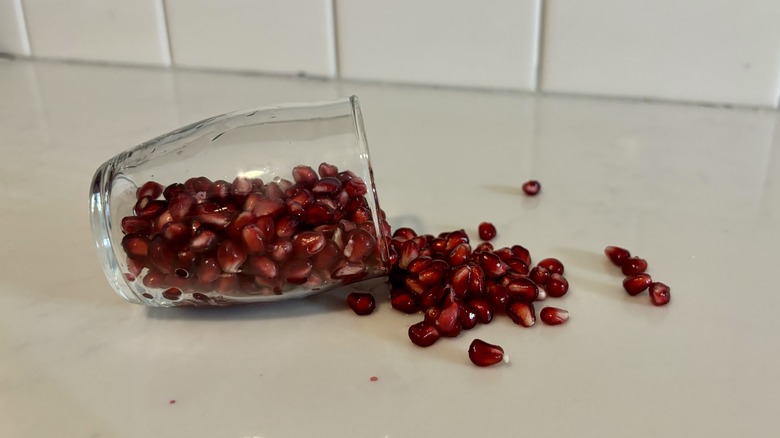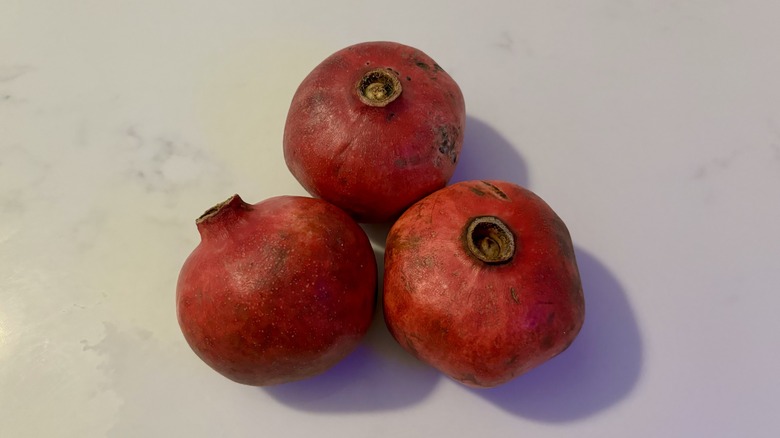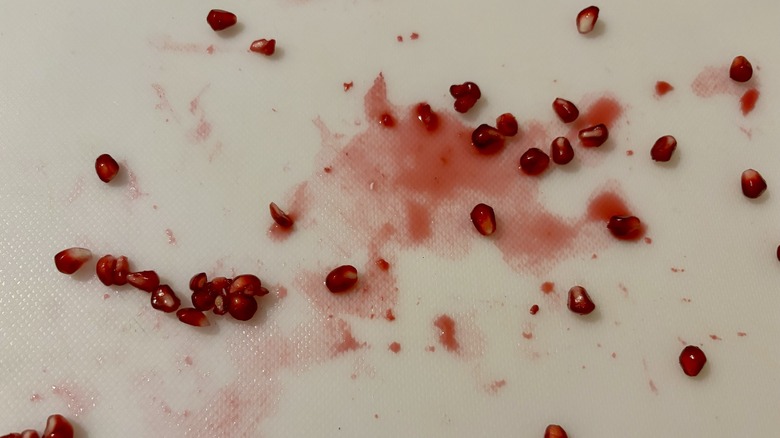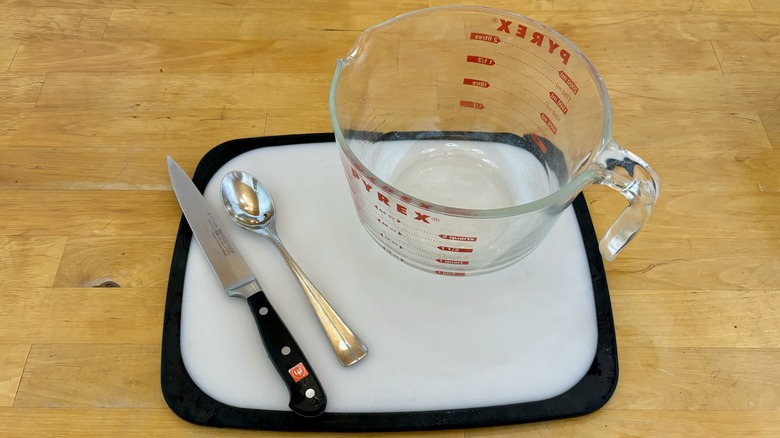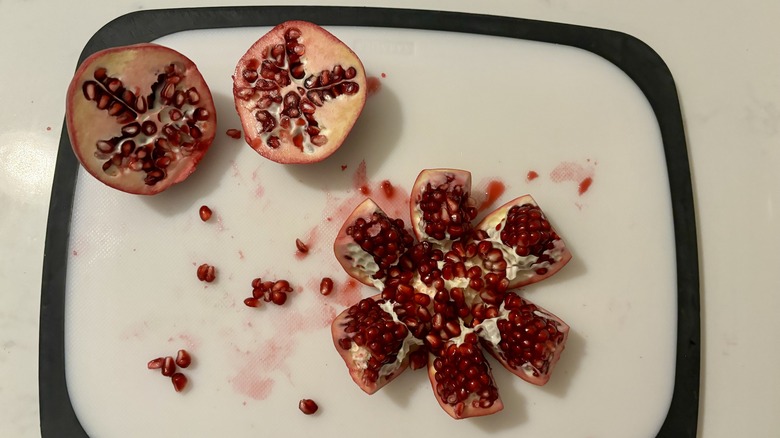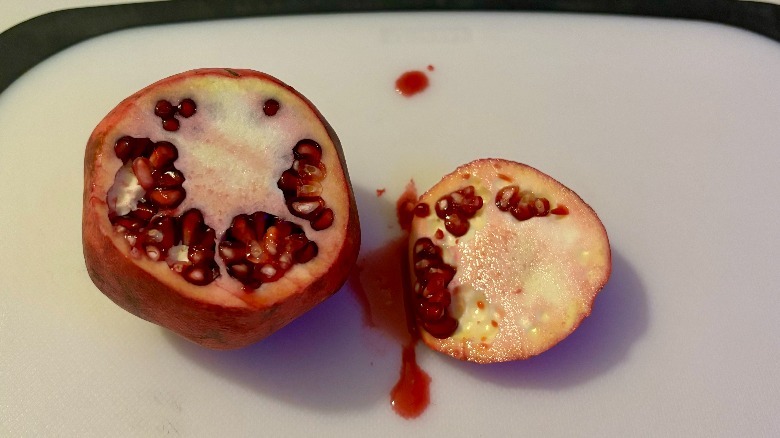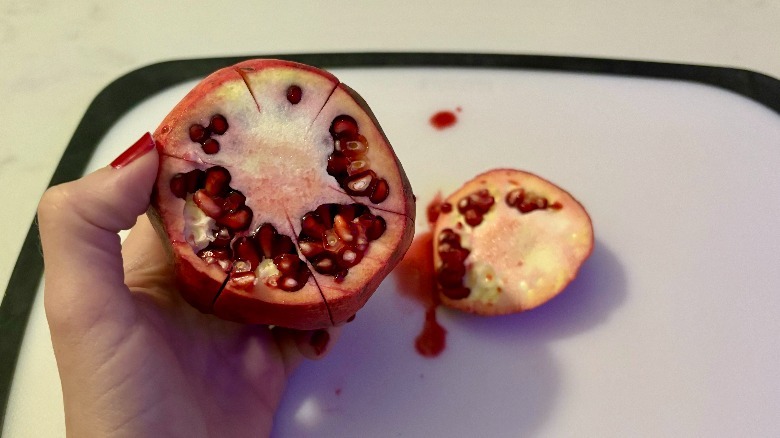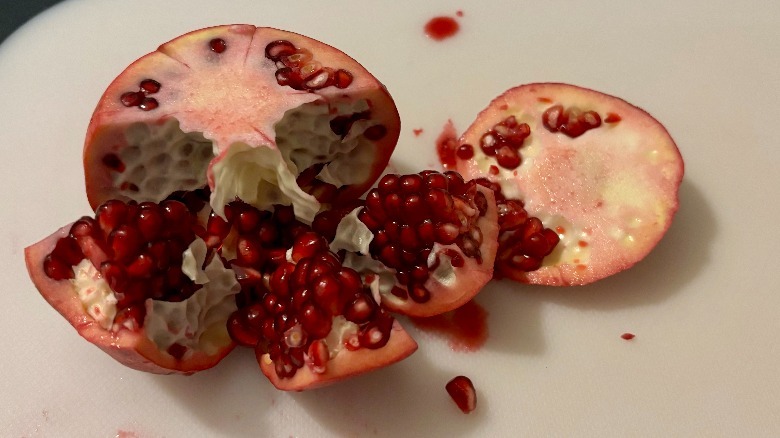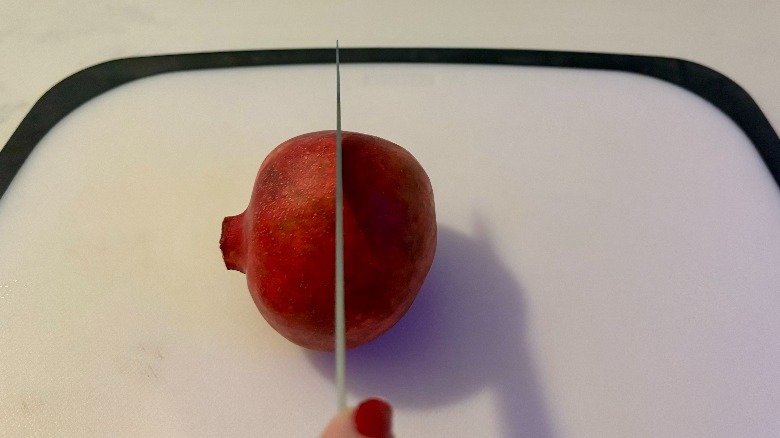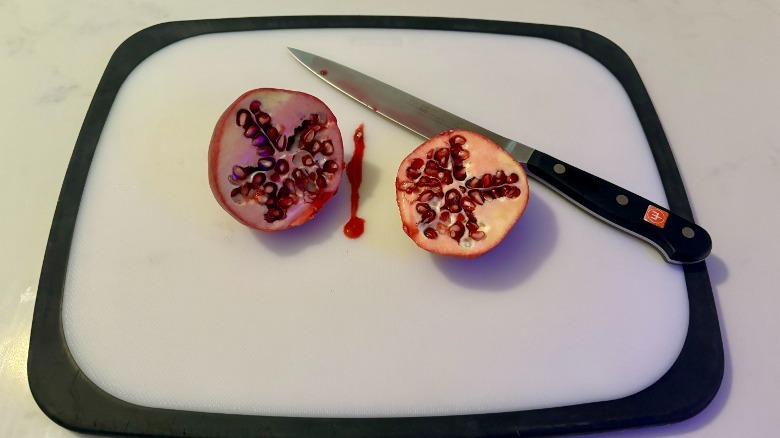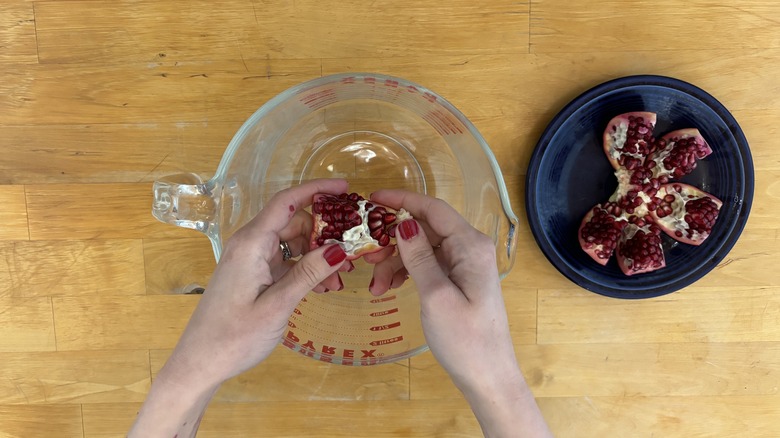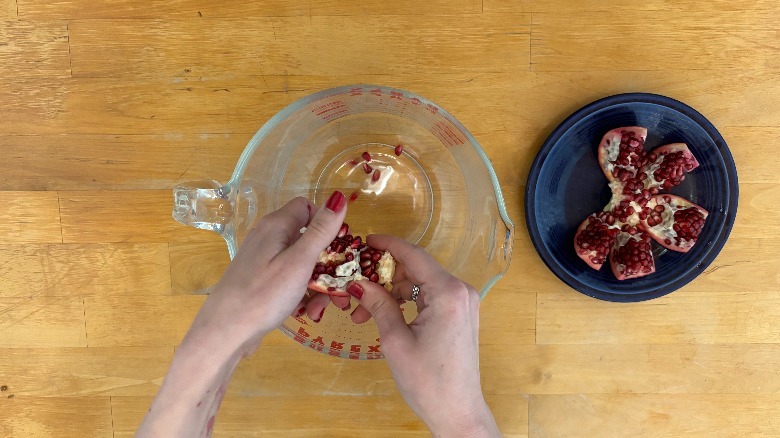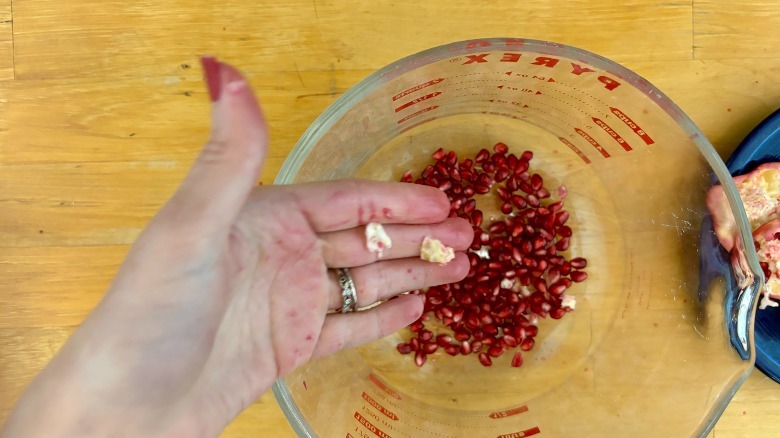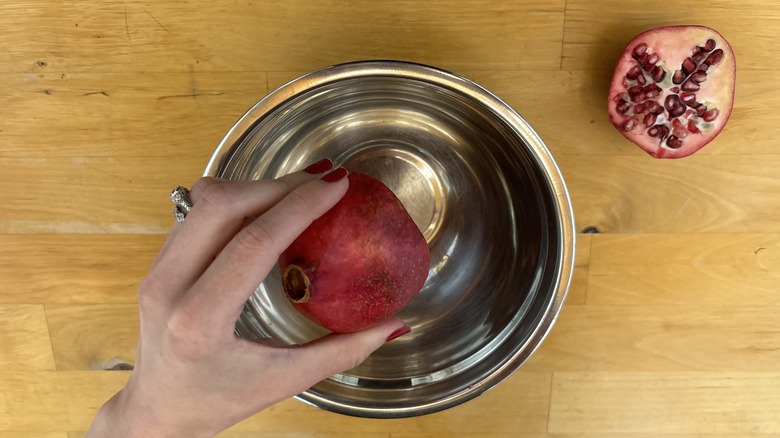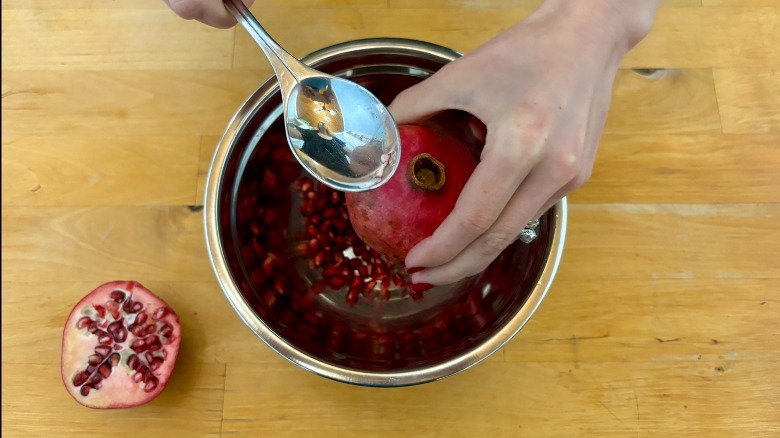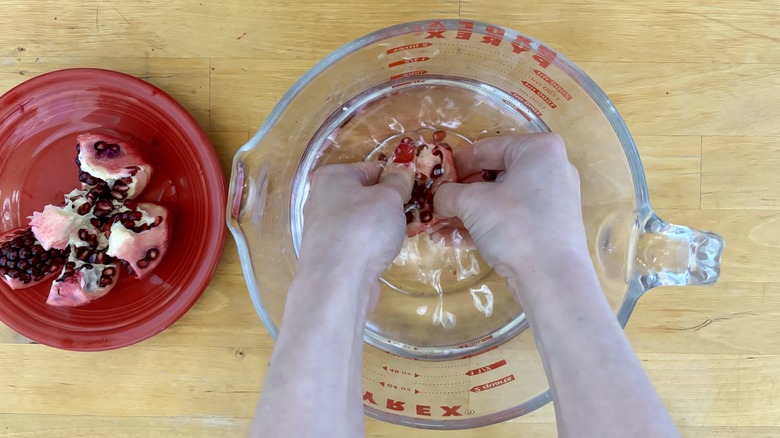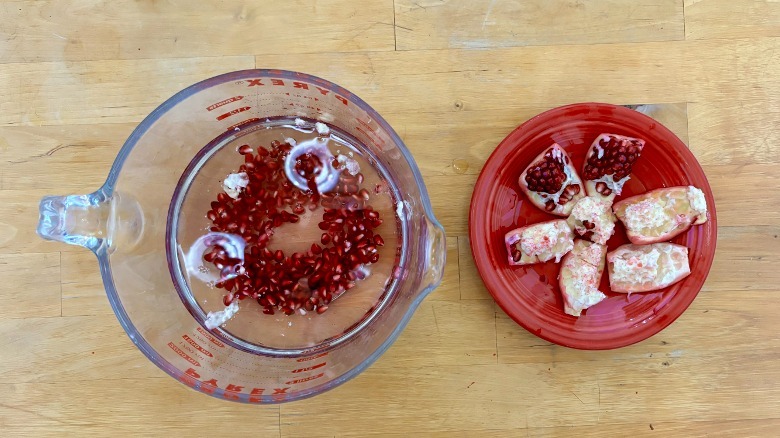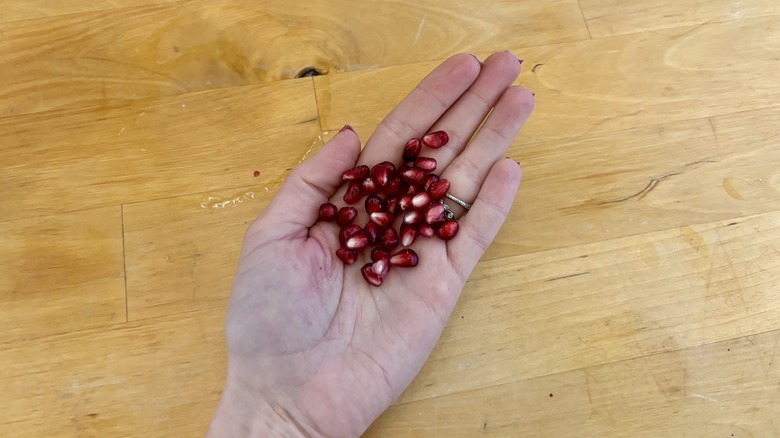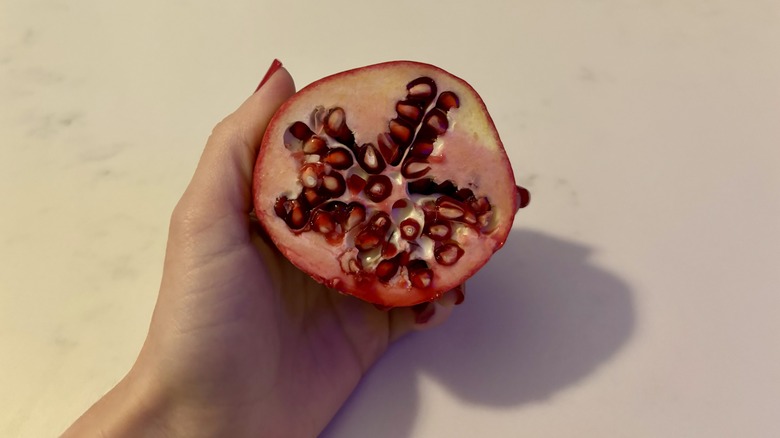How To Eat A Pomegranate Without Making A Giant Mess
Apples might get the credit for being the ultimate fall fruit, but pomegranates deserve some attention. Pomegranates take a little more work to prepare for eating than other fall fruits, but if successful, you are rewarded with tiny seeds bursting with juice and flavor. Eating a pomegranate seed is like eating candy; it pops in your mouth.
That said, we are not underestimating just how difficult it is to prepare and eat a pomegranate without making a huge mess. Between deep-colored juice that can stain anything and tiny seeds flying everywhere, preparing a pomegranate can feel like something best left to the professionals. However, with a few trips, tricks, and a little practice, any home chef can learn how to prepare a pomegranate.
We have compiled a few techniques that are guaranteed to help you on your pomegranate journey. These include several ways of cutting and deseeding the fruit to keep everything contained. You can try one or all of these methods and find the best one.
Picking the best pomegranate
Pomegranates are late fall fruit and usually pop up in grocery stores at the end of September. You can also find them in stores at other times of the year. If you spot the fruits, picking the best possible pomegranate is essential for getting the most out of your fruit, especially if you're buying out of season.
In terms of looks, the best well to tell if pomegranates are ripe is if they are bright and plump. This means the skin itself should be shiny and fully colored. No green or brown spots should be visible, as this can indicate that the fruit is under or over-ripe. Additionally, inspect for any bruises or cuts. The skin should not be wrinkly or appear to be shriveled. A fresh pomegranate will also sound hollow if you tap on the fruit.
When in doubt, pick up a few pomegranates and give them a feel. Fresh pomegranates should be just a hint soft but with no obvious weak spots. The pomegranates with the most seeds, and therefore the most edible fruit and juices, will weigh more than the others. If you are debating between a few fruits, pick them up and see how they feel.
Common pomegranate mistakes
Part of what gives pomegranates such a bad rap in terms of preparation is that a few common mistakes can turn your snack into a mess. The first is not controlling where the seeds go. If you aren't careful, it is easy to flick the pomegranate seeds off the fruit and scatter them, making a situation requiring noteworthy cleanup. Additionally, applying too much pressure to the seeds can simply pop them, causing red juice to spill everywhere.
Luckily, we will show you some easy ways to avoid these problems. That way you can enjoy your pomegranate without your kitchen looking like a murder scene.
Tools you will need
There are several different methods for preparing pomegranates for consumption. The good news is that you do not need any special tools for any of these methods. All you need is a sharp knife, a cutting board, a bowl, water, and a spoon. All of these items can be found in the average kitchen. Most methods will not even require all these items, with the most straightforward requiring just a knife, bowl, and hands.
Cutting your pomegranate
There are two main ways to cut a pomegranate. Neither is wrong; it is all a matter of preference and which preparation method you plan to use. The first is to cut it like a flower into segments, and the second is simply to cut it in half. Cutting the pomegranate into segments creates smaller pieces. Cutting the pomegranate in half is an easy way if you are looking for an efficient method for deseeding.
To cut the pomegranate into segments, start by placing your pomegranate on the cutting board sideways. Find the end with the crown on it. This is the part of the fruit that comes up in little spikes. Cut the crown off.
Next, take your pomegranate and hold it upright. You may see distinct white membrane lines. If you see these, cut them from top to bottom with your knife, going just far enough into the skin to hit the membrane. If you do not see a white membrane line, pick places and cut into six segments using the above technique.
Although deeply scored, your fruit should still be holding together in one piece at this point. Now is the time to separate the segments. Firmly grasp a segment and pull it off. Continue until all segments are separated.
To cut your pomegranate in half, take the fruit and place it sideways on the cutting board, with the crown and end facing opposite directions horizontally.
Cut your knife right down the middle, creating two equal segments with the crown on one segment and the end on the other.
Using your fingers
Take a segment of your flower-cut pomegranate and hold it firmly just above a deep and wide bowl.
While holding the segment with one hand, gently take the thumb of the other hand and push the seeds out of the membrane into the bowl. Be sure not to apply too much pressure or you risk popping the seeds. Repeat this process for the rest of the segments.
Pick out and remove any pieces of membrane before eating pomegranates.
The spoon method
Take half a cut pomegranate and hold it in one hand over a deep and wide bowl. Hold the pomegranate with your hands in a "C" shape, pinching the sides and leaving the cut top exposed. The flat pomegranate-filled side will face the bowl, while the rounded side will be up.
Take a spoon and hit the back of the pomegranate. This will loosen the seeds and cause them to fall directly into the bowl. Pick out any membrane, and enjoy your pomegranate seeds.
The underwater method
Gather a bowl full of water and a flower-cut pomegranate segment. Place the segment in the bowl under the water and gently push the seeds out of the pomegranate with your fingers. This will help control the pomegranate seeds so they don't fly everywhere and will prevent juice from squirting if one breaks.
The seeds will sink to the bottom, while any excess white membrane parts should float to the top. Drain off the membrane and the excess water, and enjoy your pomegranate.
Eating your pomegranate
Now that your pomegranate seeds are available, there are plenty of ways to enjoy them. You can eat them straight. The little sweet and tart juice pops are a fun and delicious snack. They can also be used to garnish food such as wild rice and walnut stuffed acorn squash. The seeds can also be added to smoothies or fruit salads.
Storing pomegranate seeds
If left intact, whole pomegranates can last up to a month. Placing them in the refrigerator will help them last longer. Left on the counter, they will last about two weeks. For Increased longevity, keep the fruits out of direct sunlight.
If you end up with extra pomegranate seeds, you may be wondering how to store them. The seeds can be placed in an airtight container and stored in the refrigerator for four to five days. Alternatively, they can be placed in the freezer, where they will last up to six months.
